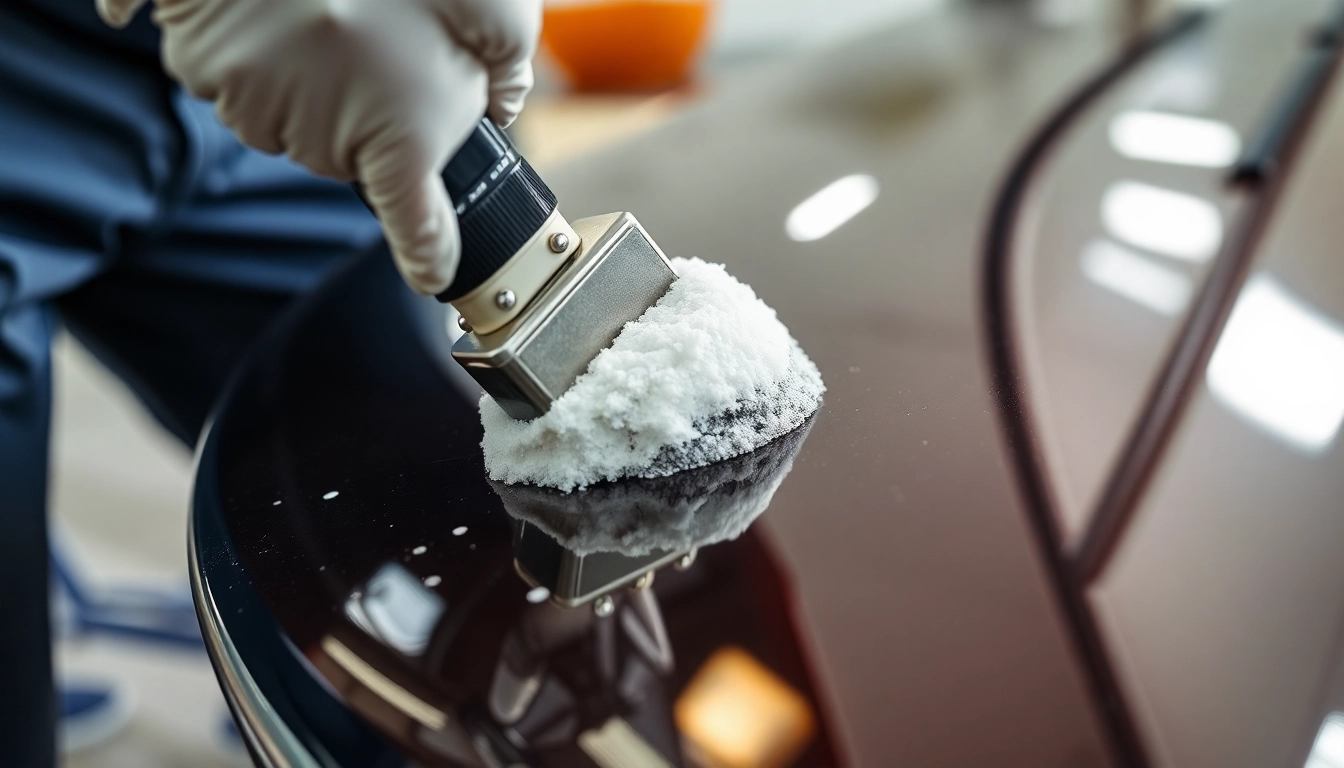Fundamentals of Boat Sealant: Why It Is Indispensable for Watercraft Protection
What Is Boat Sealant and How Does It Work?
Boat sealant, often referred to as Boots Versiegelung, is a specialized protective coating designed to shield your watercraft’s hull, gelcoat, or paint surfaces from environmental stressors. The primary function of a marine sealant is to create a durable, hydrophobic barrier that prevents water ingress, resists UV degradation, and guards against dirt, salt, and other pollutants. These sealants are formulated using advanced polymer or ceramic technologies, which bond tightly with the surface, offering long-lasting protection and enhancing the vessel’s gloss and smoothness.
The working mechanism involves a chemical reaction during application, forming a robust layer that adheres seamlessly to the surface. Modern formulations often incorporate nanotechnology, enabling the sealant to fill microscopic pores and surface irregularities, resulting in a uniform protective film that significantly reduces maintenance needs and preserves the aesthetic appeal.
Advantages of Professional Watercraft Sealing
Investing in professional-grade sealing offers numerous benefits:
- Enhanced Durability: High-quality sealants withstand harsh marine conditions, including saltwater, UV rays, and abrasive debris, extended over months or even years.
- Improved Appearance: A well-applied sealant elevates gloss and smoothness, retaining the boat’s market value while showcasing a freshly maintained look.
- Protection Against Corrosion: By preventing water and moisture penetration, sealants help avoid corrosion of metal components and structural damage.
- Ease of Maintenance: Surfaces treated with marine sealant are easier to clean, allowing dirt and pollutants to be rinsed off effortlessly.
- Environmental Resistance: Sealants serve as a barrier against sun damage, algae, and pollutants, ensuring longer intervals between reapplications.
Common Misconceptions and Clarifications
Despite widespread adoption, several myths surround boat sealing:
- Sealing Is Optional: In reality, neglecting sealing accelerates surface aging and deterioration, especially in saltwater environments.
- All Sealants Are the Same: Not true—different formulations offer varying levels of protection, ease of application, and lifespan.
- Sealing Eliminates the Need for Cleaning: While it reduces dirt buildup, regular cleaning remains essential for sustained shine and performance.
Understanding these facts ensures optimal maintenance and prolongs the lifespan of your watercraft.
Selecting the Optimal Boat Sealant: Criteria and Recommendations
Materials and Surface Types: Gelcoat, Paint, and Fiberglass
The effectiveness of a sealant depends heavily on compatibility with your boat’s materials. Gelcoat and fiberglass surfaces dominate marine vessels due to their resilience and aesthetic appeal. Sealants designed specifically for gelcoat provide superior adhesion and flexibility, preventing cracking and peeling. For painted surfaces, ensure compatibility with the coating type to avoid discoloration or degradation. A versatile sealant that adheres across different materials simplifies maintenance routines, while some advanced formulations include ceramic nanocoatings, offering near-permanent protection on gelcoat and fibreglass.
The Science Behind Polymer and Ceramic Sealants
Polymer-based sealants, often utilizing high molecular weight compounds, form a flexible, resilient barrier. They excel in UV resistance and maintain gloss over time. Ceramic coatings, on the other hand, leverage nanoceramics—tiny particles that create an ultra-hard layer, providing exceptional resistance to scratches, chemical etching, and environmental contaminants. These ceramic coatings can last 2-5 years depending on maintenance and environmental conditions.
Both types of sealants undergo curing processes that involve polymerization or chemical bonding, requiring proper surface prep for optimal results. Advanced formulations are increasingly incorporating hybrid technologies, combining polymers with ceramics to maximize protection and longevity.
Product Comparisons and Leading Brands
Choosing the right product involves evaluating brand reputation, formulation efficacy, and ease of application. Brands like Gtechniq, Menzerna, and Kock Chemie are renowned for their innovative marine coatings. For example, Gtechniq’s ceramic top coatings offer industry-leading hydrophobicity and longevity, making them ideal for high-end watercraft. Comparing features such as curing time, hydrophobicity level, and price point helps in decision-making. Practical testing and user reviews reveal performance differences, with many users prioritizing products that balance ease of application with long-term durability.
Step-by-Step Application of Boat Sealant
Preparing Your Surface for Maximum Effectiveness
Surface preparation is crucial. Begin by thoroughly cleaning the boat with a dedicated marine cleaner like the Power Cleaner to remove dirt, salt, and organic contaminants. Use a clay bar or specialized polishing pads if necessary to eliminate embedded debris. Follow cleaning with a decontamination wash and ensure the surface is completely dry. If there are existing contaminants or oxidation, apply a polishing compound such as the Power Polish to restore surface integrity and enhance adhesion.
Application Procedure: Step-by-Step Guide
- Choose the right weather conditions: Apply sealant on a shaded, dry day to prevent rapid drying or streaking.
- Apply to a small section: Use an applicator pad or microfiber towel to spread an even layer of sealant across a manageable surface area.
- Follow manufacturer instructions: Cure times vary—typically, wait 15-30 minutes for polymer sealants or 1-2 hours for ceramic coatings.
- Buff to a high gloss: Use a clean, soft microfiber cloth to remove excess, ensuring a streak-free finish.
- Repeat if necessary: For maximum protection, multiple layers can be applied, allowing curing time between coats.
Post-Application Care and Maintenance
After sealing, avoid washing the boat for at least 24 hours. Use a gentle, pH-neutral marine soap and soft microfiber towels to clean the surface regularly. Reapply the sealant as recommended—typically annually—to maintain optimal protection. During cleaning, utilize specialized tools like the BCC Towels Vorteilspack and washing gloves for safe and effective care.
Post-Sealing Maintenance and Longevity Tips
Cleaning Tips for Sustained Shine
Regular cleaning with a dedicated marine wash prevents dirt and grime buildup, which can compromise the protective layer. For stubborn stains or oxidation, gentle polishing with the Power Polish restores luster without damaging the sealant. Always rinse thoroughly and avoid harsh abrasives that can degrade the coating.
Routine Maintenance for Extended Protection
Incorporate protective measures such as applying a wax benefitting from a synergy with your sealant, or an additional layer of ceramic coating for high-traffic or exposure areas. Using tools like the BCC Snow Foam Gun ensures a thick foam layer that loosens contaminants, making cleaning more effective and less abrasive.
Troubleshooting and Damage Repair
Scratches, oxidation, or peeling can occur over time. Minor scratches can be polished out using compatible compounds, followed by reapplication of sealant or coating. For significant damage, consider professional restoration or applying a fresh layer of protective coating to restore the original surface integrity.
Emerging Technologies and Future Trends in Boat Sealants
Breakthroughs in Polymer and Ceramic Coatings
Advances in nanotechnology continue to push the boundaries of marine protection. Next-generation polymer coatings now feature self-healing capabilities, where microcapsules release healing agents upon surface damage, and ultra-hard ceramic layers with enhanced slip resistance. Such innovations promise longer-lasting protection with less frequent application, aligning with the industry’s shift toward maintenance-free solutions.
Sustainability and Eco-Friendly Solutions
Environmental consciousness influences product development. Eco-friendly sealants now utilize biodegradable polymers and avoid harmful solvents, reducing ecological impact. Water-based formulations are gaining popularity, offering ease of application and safe removal, especially important as regulations tighten on the use of volatile organic compounds (VOCs) and persistent chemicals.
Smart Maintenance Integration
The integration of smart sensors and IoT technology into marine maintenance is on the rise. These sensors monitor surface conditions and alert owners when reapplication is due, streamlining maintenance schedules and optimizing product usage. Such innovations aim to make boat care more precise, efficient, and accessible to both amateurs and professionals alike.

